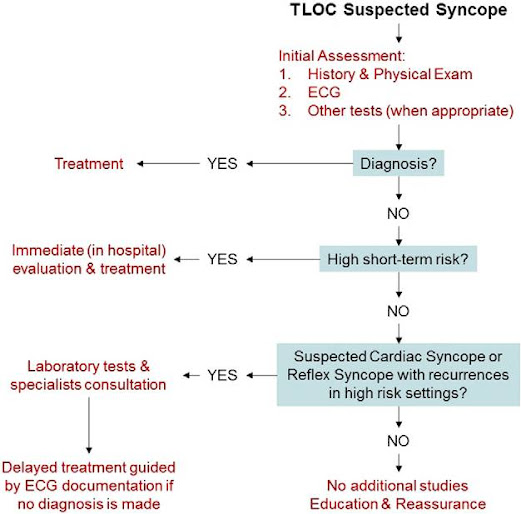New Concepts in the Assessment of Syncope
J Am Coll Cardiol 2012;59:1583–91
Definition
Transient loss of consciousness (TLOC) or faint are generic terms that encompass all disorders characterized by transient, self-limited, nontraumatic loss of consciousness.
Prognosis
The outcome in patients with syncope is often related to the severity of the underlying disease rather than the syncopal event itself.
Classification of Syncope According to Etiology [Modified by ESC (European Society of Cardiology) Guidelines] Versus Classification According to Mechanism [Modified by ISSUE (International Study on Syncope of Uncertain Etiology) Classification]

The Diagnostic Algorithm of a Patient Presenting With TLOC of Suspected Syncopal Nature

Short-Term High-Risk Criteria That Require Prompt Hospitalization or Early Intensive Evaluation
ESC Guidelines
- Severe structural or coronary artery disease (heart failure, low ejection fraction, or previous myocardial infarction)
- ECG features suggesting arrhythmic syncope (nonsustained ventricular tachycardia, bifascicular block, inadequate sinus bradycardia ( 50 < bpm) or sinoatrial block, pre-excited QRS complex, ECG findings suggesting an inherited disease)
- Clinical features suggesting arrhythmic syncope (syncope during exertion or supine position, palpitations at the time of syncope, family history of sudden cardiac death)
- Important comorbidities:
- Severe anemia
- Electrolyte disturbance
Canadian Cardiovascular Society Position Paper
- Heart failure and history of cardiac disease (ischemic, arrhythmic, obstructive, valvular)
- Abnormal ECG (any bradyarrhythmia, tachyarrhythmia, or conduction disease; new ischemia or old infarct)
- Hypotension (SBP < 90 mmHg)
- Minor risk factors deserving urgent specialist assessment: age > 60 years, dyspnea, anemia (hematocrit < 30%), hypertension, cerebrovascular disease, family history of sudden death 50 years, syncope while supine, syncope during exercise, syncope with no prodromal symptoms








沒有留言:
張貼留言